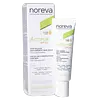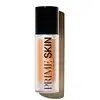What's inside
What's inside
 Key Ingredients
Key Ingredients

 Benefits
Benefits

 Concerns
Concerns

 Ingredients Side-by-side
Ingredients Side-by-side

Water
Skin ConditioningCyclopentasiloxane
EmollientTitanium Dioxide
Cosmetic ColorantEthyl Methoxycinnamate
UV AbsorberCI 77891
Cosmetic ColorantZinc Oxide
Cosmetic ColorantPropanediol
SolventPolysilicone-15
UV FilterDimethicone
EmollientCetyl PEG/PPG-10/1 Dimethicone
EmulsifyingMethyl Methacrylate Crosspolymer
Aluminum Hydroxide
EmollientDisteardimonium Hectorite
StabilisingBis-PEG/PPG-14/14 Dimethicone
EmollientBisabolol
MaskingLarix Europaea Wood Extract
HumectantOenothera Biennis Oil
EmollientCeramide AP
Skin ConditioningPhytosphingosine
Skin ConditioningCholesterol
EmollientCeramide NP
Skin ConditioningCeramide EOP
Skin ConditioningStearic Acid
CleansingCI 77492
Cosmetic ColorantMagnesium Sulfate
Parfum
MaskingCaprylyl Glycol
EmollientTocopheryl Acetate
AntioxidantSodium Benzoate
MaskingPropylene Carbonate
SolventBentonite
AbsorbentCI 77491
Cosmetic ColorantPotassium Sorbate
PreservativeChlorphenesin
AntimicrobialDisodium EDTA
CI 77499
Cosmetic ColorantXanthan Gum
EmulsifyingCaprylhydroxamic Acid
Glycerin
HumectantDimethiconol
EmollientTriethoxycaprylylsilane
Sodium Polyacrylate
AbsorbentDisodium Stearoyl Glutamate
CleansingSodium Lauroyl Lactylate
EmulsifyingPhenylpropanol
MaskingPhenoxyethanol
PreservativeCarbomer
Emulsion StabilisingEthylhexylglycerin
Skin ConditioningPentaerythrityl Tetra-Di-T-Butyl Hydroxyhydrocinnamate
AntioxidantTriisopropanolamine
BufferingTocopherol
AntioxidantWater, Cyclopentasiloxane, Titanium Dioxide, Ethyl Methoxycinnamate, CI 77891, Zinc Oxide, Propanediol, Polysilicone-15, Dimethicone, Cetyl PEG/PPG-10/1 Dimethicone, Methyl Methacrylate Crosspolymer, Aluminum Hydroxide, Disteardimonium Hectorite, Bis-PEG/PPG-14/14 Dimethicone, Bisabolol, Larix Europaea Wood Extract, Oenothera Biennis Oil, Ceramide AP, Phytosphingosine, Cholesterol, Ceramide NP, Ceramide EOP, Stearic Acid, CI 77492, Magnesium Sulfate, Parfum, Caprylyl Glycol, Tocopheryl Acetate, Sodium Benzoate, Propylene Carbonate, Bentonite, CI 77491, Potassium Sorbate, Chlorphenesin, Disodium EDTA, CI 77499, Xanthan Gum, Caprylhydroxamic Acid, Glycerin, Dimethiconol, Triethoxycaprylylsilane, Sodium Polyacrylate, Disodium Stearoyl Glutamate, Sodium Lauroyl Lactylate, Phenylpropanol, Phenoxyethanol, Carbomer, Ethylhexylglycerin, Pentaerythrityl Tetra-Di-T-Butyl Hydroxyhydrocinnamate, Triisopropanolamine, Tocopherol
Water
Skin ConditioningCyclopentasiloxane
EmollientButylene Glycol
HumectantPhenyl Trimethicone
Skin ConditioningIsododecane
EmollientPEG-10 Dimethicone
Skin ConditioningAluminum Hydroxide
EmollientStearic Acid
CleansingTocopherol
AntioxidantTocopheryl Acetate
AntioxidantTetrahexyldecyl Ascorbate
AntioxidantRetinyl Palmitate
Skin ConditioningBHT
AntioxidantGlycyrrhiza Glabra Root Extract
BleachingNylon-6/12
AbsorbentOlive Glycerides
EmulsifyingCeramide NP
Skin ConditioningNylon-12
Sodium Hyaluronate
HumectantBis-PEG/PPG-14/14 Dimethicone
EmollientMethicone
EmollientBoron Nitride
AbsorbentDisteardimonium Hectorite
StabilisingTriethoxycaprylylsilane
Sodium Chloride
MaskingSodium Dehydroacetate
PreservativeDisodium EDTA
Hexylene Glycol
EmulsifyingCaprylyl Glycol
EmollientPhenoxyethanol
PreservativeTitanium Dioxide 5%
Cosmetic ColorantEthylhexyl Methoxycinnamate 7.5%
UV AbsorberWater, Cyclopentasiloxane, Butylene Glycol, Phenyl Trimethicone, Isododecane, PEG-10 Dimethicone, Aluminum Hydroxide, Stearic Acid, Tocopherol, Tocopheryl Acetate, Tetrahexyldecyl Ascorbate, Retinyl Palmitate, BHT, Glycyrrhiza Glabra Root Extract, Nylon-6/12, Olive Glycerides, Ceramide NP, Nylon-12, Sodium Hyaluronate, Bis-PEG/PPG-14/14 Dimethicone, Methicone, Boron Nitride, Disteardimonium Hectorite, Triethoxycaprylylsilane, Sodium Chloride, Sodium Dehydroacetate, Disodium EDTA, Hexylene Glycol, Caprylyl Glycol, Phenoxyethanol, Titanium Dioxide 5%, Ethylhexyl Methoxycinnamate 7.5%
 Reviews
Reviews

Ingredients Explained
These ingredients are found in both products.
Ingredients higher up in an ingredient list are typically present in a larger amount.
Aluminum Hydroxide is a form of aluminum. It can be naturally found in nature as the mineral gibbsite. In cosmetics, Aluminum Hydroxide is used as a colorant, pH adjuster, and absorbent.
As a colorant, Aluminum Hydroxide may add opacity, or reduce the transparency. Aluminum hydroxide is contains both basic and acidic properties.
According to manufacturers, this ingredient is an emollient and humectant. This means it helps hydrate the skin.
In medicine, this ingredient is used to help relieve heartburn and help heal ulcers.
There is currently no credible scientific evidence linking aluminum hydroxide in cosmetics to increased cancer risk.
Major health organizations allow the use of aluminum hydroxide in personal care products and have not flagged it as a carcinogenic risk at typical usage levels.
Learn more about Aluminum HydroxideBis-PEG/PPG-14/14 Dimethicone is a type of silicone.
Caprylyl Glycol is a humectant and emollient, meaning it attracts and preserves moisture.
It is a common ingredient in many products, especially those designed to hydrate skin. The primary benefits are retaining moisture, skin softening, and promoting a healthy skin barrier.
Though Caprylyl Glycol is an alcohol derived from fatty acids, it is not the kind that can dry out skin.
This ingredient is also used as a preservative to extend the life of products. It has slight antimicrobial properties.
Learn more about Caprylyl GlycolCeramide NP is a type of ceramide and formally known as ceramide 3.
Ceramides are intercellular lipids naturally found in our skin that bonds dead skin cells together to create a barrier. They are known for their ability to hold water and thus are a great ingredient for dry skin.
Ceramides are an important building block for our skin barrier. A stronger barrier helps the skin look more firm and hydrated. By bolstering the skin ceramides act as a barrier against irritating ingredients. This can help with inflammation as well.
If you would like to eat ceramides, sweet potatoes contain a small amount.
Read more about other common types of ceramides here:
Ceramide AP
Ceramide EOP
Cyclopentasiloxane, or D5, is a silicone used to improve texture of products and trap moisture.
D5 is considered lightweight and volatile. Volatile means it evaporates quickly after application. Once evaporated, D5 leaves a thin barrier that helps keep skin hydrated.
It is also an emollient. Emollients help soften the skin and prevent water loss. Silicones create a silky texture in products. D5 helps other ingredients become more spreadable.
Studies show D5 is safe to use in skincare products. We recommend speaking with a skincare professional if you have concerns.
Learn more about CyclopentasiloxaneDisodium EDTA plays a role in making products more stable by aiding other preservatives.
It is a chelating agent, meaning it neutralizes metal ions that may be found in a product.
Disodium EDTA is a salt of edetic acid and is found to be safe in cosmetic ingredients.
Learn more about Disodium EDTADisteardimonium Hectorite comes from the clay mineral named hectorite. It is used to add thickness to a product.
It can also help stabilize a product by helping to disperse other ingredients.
Hectorite is a rare, white clay mineral.
Learn more about Disteardimonium HectoritePhenoxyethanol is a preservative that has germicide, antimicrobial, and aromatic properties. Studies show that phenoxyethanol can prevent microbial growth. By itself, it has a scent that is similar to that of a rose.
It's often used in formulations along with Caprylyl Glycol to preserve the shelf life of products.
Stearic Acid is a fatty acid. It is an emollient, emulsifier, and texture enhancer.
As an emollient, stearic acid helps soften skin. It aids the skin's protective barrier by preventing water loss. It also provides a gentle cleansing effect without stripping away natural oils.
Stearic acid may also be used to enhance the texture of products. It can add volume and stabilize ingredients such as water and oil. This can help water and oil ingredients from separating.
Sources of stearic acid include animal or vegetable fats/oils such as coconut or shea. It can be naturally found in butter, cocoa butter, shea butter, vegetable fats, and animal tallow.
This ingredient may not be Malassezia folliculitis, or fungal-acne safe.
Learn more about Stearic AcidTitanium dioxide is a mineral UV filter widely used in sunscreens and cosmetics.
It is one of only two UV filters officially classified as “mineral” by regulatory agencies, the other being zinc oxide.
Titanium dioxide provides broad-spectrum protection mostly in the UVB and UVAII range, with some protection in the UVAI range.
While its UVA protection isn’t as strong as zinc oxide’s, the difference is minor.
A common myth is that mineral UV filters reflect UV light. However, modern research shows titanium dioxide absorbs UV radiation like chemical filters (~95% absorption & 5% reflection).
Thanks to its non-irritating nature, titanium dioxide is suitable for sensitive, acne-prone, or redness-prone skin. It is unlikely to cause "eye sting" like other sunscreen ingredients.
A major drawback of this ingredient is its white cast and thick texture. This is why mineral sunscreens often leave a white cast and are less cosmetically elegant than chemical/hybrid sunscreens.
To improve white cast and spreadability, micronized or nano-sized titanium dioxide is often used.
There are ongoing concerns surrounding nano-titanium oxide's impact on marine ecosystems.
There is no conclusive evidence that any form of titanium oxide (or any other sunscreen ingredients) will cause harm to marine ecosystems or coral reefs. The science is still developing but many consumers are keeping a close eye on this issue.
Please note, many destinations have reef-safety sunscreen rules. For instance, the U.S. Virgin Islands advises all visitors to use non-nano mineral sunscreens.
Nano mineral sunscreens once raised safety concerns about absorption into skin.
Extensive research has shown that they do not penetrate healthy or damaged skin; they remain safely on the surface and the top layer of dead skin (stratum corneum).
You'll likely find titanium dioxide bundled with alumina, silica, or dimethicone. These ingredients help make titanium dioxide highly photostable; this prevents it from interacting with other formula components under UV light.
Learn more about Titanium DioxideTocopherol (also known as Vitamin E) is a common antioxidant used to help protect the skin from free-radicals and strengthen the skin barrier. It's also fat soluble - this means our skin is great at absorbing it.
Vitamin E also helps keep your natural skin lipids healthy. Your lipid skin barrier naturally consists of lipids, ceramides, and fatty acids. Vitamin E offers extra protection for your skin’s lipid barrier, keeping your skin healthy and nourished.
Another benefit is a bit of UV protection. Vitamin E helps reduce the damage caused by UVB rays. (It should not replace your sunscreen). Combining it with Vitamin C can decrease sunburned cells and hyperpigmentation after UV exposure.
You might have noticed Vitamin E + C often paired together. This is because it is great at stabilizing Vitamin C. Using the two together helps increase the effectiveness of both ingredients.
There are often claims that Vitamin E can reduce/prevent scarring, but these claims haven't been confirmed by scientific research.
Learn more about TocopherolTocopheryl Acetate is AKA Vitamin E. It is an antioxidant and protects your skin from free radicals. Free radicals damage the skin by breaking down collagen.
One study found using Tocopheryl Acetate with Vitamin C decreased the number of sunburned cells.
Tocopheryl Acetate is commonly found in both skincare and dietary supplements.
Learn more about Tocopheryl AcetateTriethoxycaprylylsilane is a silicone used to bind and stabilize ingredients.
As an emulsifier, it helps prevent ingredients from separating. This can help elongate the shelf life of products.
Triethoxycaprylylsilane is often used to coat mineral sunscreens ingredients to help give a better feel. It also helps reduce oxidative stress in sunscreens.
Learn more about TriethoxycaprylylsilaneWater. It's the most common cosmetic ingredient of all. You'll usually see it at the top of ingredient lists, meaning that it makes up the largest part of the product.
So why is it so popular? Water most often acts as a solvent - this means that it helps dissolve other ingredients into the formulation.
You'll also recognize water as that liquid we all need to stay alive. If you see this, drink a glass of water. Stay hydrated!
Learn more about Water